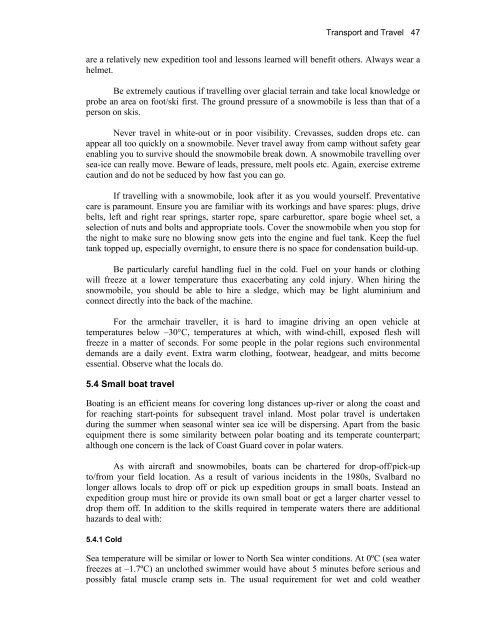Edited by Rachel Duncan 4th Edition ISBN 0-907649-91-2 London ...
Edited by Rachel Duncan 4th Edition ISBN 0-907649-91-2 London ...
Edited by Rachel Duncan 4th Edition ISBN 0-907649-91-2 London ...
Create successful ePaper yourself
Turn your PDF publications into a flip-book with our unique Google optimized e-Paper software.
Transport and Travel 47<br />
are a relatively new expedition tool and lessons learned will benefit others. Always wear a<br />
helmet.<br />
Be extremely cautious if travelling over glacial terrain and take local knowledge or<br />
probe an area on foot/ski first. The ground pressure of a snowmobile is less than that of a<br />
person on skis.<br />
Never travel in white-out or in poor visibility. Crevasses, sudden drops etc. can<br />
appear all too quickly on a snowmobile. Never travel away from camp without safety gear<br />
enabling you to survive should the snowmobile break down. A snowmobile travelling over<br />
sea-ice can really move. Beware of leads, pressure, melt pools etc. Again, exercise extreme<br />
caution and do not be seduced <strong>by</strong> how fast you can go.<br />
If travelling with a snowmobile, look after it as you would yourself. Preventative<br />
care is paramount. Ensure you are familiar with its workings and have spares: plugs, drive<br />
belts, left and right rear springs, starter rope, spare carburettor, spare bogie wheel set, a<br />
selection of nuts and bolts and appropriate tools. Cover the snowmobile when you stop for<br />
the night to make sure no blowing snow gets into the engine and fuel tank. Keep the fuel<br />
tank topped up, especially overnight, to ensure there is no space for condensation build-up.<br />
Be particularly careful handling fuel in the cold. Fuel on your hands or clothing<br />
will freeze at a lower temperature thus exacerbating any cold injury. When hiring the<br />
snowmobile, you should be able to hire a sledge, which may be light aluminium and<br />
connect directly into the back of the machine.<br />
For the armchair traveller, it is hard to imagine driving an open vehicle at<br />
temperatures below –30°C, temperatures at which, with wind-chill, exposed flesh will<br />
freeze in a matter of seconds. For some people in the polar regions such environmental<br />
demands are a daily event. Extra warm clothing, footwear, headgear, and mitts become<br />
essential. Observe what the locals do.<br />
5.4 Small boat travel<br />
Boating is an efficient means for covering long distances up-river or along the coast and<br />
for reaching start-points for subsequent travel inland. Most polar travel is undertaken<br />
during the summer when seasonal winter sea ice will be dispersing. Apart from the basic<br />
equipment there is some similarity between polar boating and its temperate counterpart;<br />
although one concern is the lack of Coast Guard cover in polar waters.<br />
As with aircraft and snowmobiles, boats can be chartered for drop-off/pick-up<br />
to/from your field location. As a result of various incidents in the 1980s, Svalbard no<br />
longer allows locals to drop off or pick up expedition groups in small boats. Instead an<br />
expedition group must hire or provide its own small boat or get a larger charter vessel to<br />
drop them off. In addition to the skills required in temperate waters there are additional<br />
hazards to deal with:<br />
5.4.1 Cold<br />
Sea temperature will be similar or lower to North Sea winter conditions. At 0ºC (sea water<br />
freezes at –1.7ºC) an unclothed swimmer would have about 5 minutes before serious and<br />
possibly fatal muscle cramp sets in. The usual requirement for wet and cold weather

















